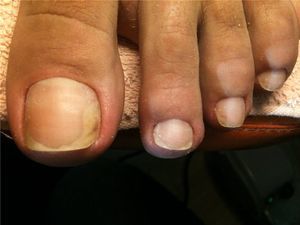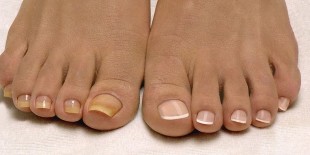Among the common people different diseases that are not life-threatening, but generate serious discomfort. Onychomycosis is a representative fungal diseases. It affects the nail plate, completely destroying them. Humid and warm environment ideal for its spread. Symptoms of fungal toenails are often hidden, and eventually the disease is detected already underway in the form.

Principal mycoses
Nails have suffered a variety of mycosis. The most common dermatophytes. Red Trichophyton affect the skin the hands and feet. Its main symptoms — a place of yellow or white color of the nail plates. Gradually the area of infection grows, the color changes to the entire nail, and he began to move away from the bed. In severe cases, this leads to a fungus that affects the skin.
Trichophyton Mentagrophytes toes in the starting area, then moves above. It looks like a yellow or white point, which transformirovalsya in subungual hyperkeratosis. The disease usually only affects the thumb or fingers. The pathogen actively multiplies in the warm time of the year.
Much less common Trichophyton purple. It is more common in the far east and Central Asia. Affects the scalp and is commonly known as ringworm. If left untreated, the nails dark bumps.
Fungus under nail, and it is caused due to the yeast infection fungi. Pathogens — Candida white and Candida parapsilosis. The disease usually appears in the background of the already existing onychomycosis.
The main signs of yeast-like fungi:
- white spots on the nails, which eventually will become gray;
- inflammation of the epidermis;
- purulent discharge.
All of these symptoms bring pain. Often yeast-like fungi to become a professional disease, which develops in persons who have permanent contact with water. In the absence of timely treatment of the nail plate thinning and moving away from the bed.
More rarely, mold. The first is similar to the symptoms of Candida and it usually occurs after injuries of the thumb, and the second color nails with black dots.

Classification of fungal infections
Symptoms of nail fungus is diverse. They depend on the form of the disease and its severity. Some doctors share mycosis is the localization and depth of penetration:
- When the distal shape is touched on the surface free edge, the disc changes color to brown or yellow. Eventually the area affected area increase, and the structure of the nail changed to a rough, uneven.
- The lateral shape occurs in the same way, only the affected side of the nail.
- When the proximal form of the infection starts the cuticle. Skin roller to spread the white spot, which is becoming more. The surface becomes cloudy and loses its gloss, in severe cases, begins to crumble.
Some doctors prefer to classify the disease based on the degree of thickening of the nail. Under normal trophic form, it still does not change the size, but the visible foci of the disease. In hypertrophic is overgrowth of skin, which leads to thickening of the nail and discomfort when walking. Atrophic form leads to the complete rejection of the nail plate.
The complexity of treatment of fungal toenails is that in most cases the disease is detected at later stages, when atrophy occurs. The first signs of infection — spots or stripes on the nail plates. They do not cause discomfort, which people do not pay attention to the problem in a timely manner.
Characteristic symptoms
You can determine how the fungus toenails, is quite simple: the disc will appear colored spots, it can be deformed, to stratify and to move away from the bed. If the disease side panels are red and peel. Some forms are accompanied by a rash on the toes area.
Another characteristic symptom is burning and itching. Leather side panels thickens and starts to peel off, after which irritation occurs. Scratching only intensifies it is a very unpleasant feeling.
The first sign of nail fungus on your feet not only change the color of the plate, but the loss of her Shine. It becomes cloudy, with the progression of the disease becomes gray. When trying to cut actively crumbles and breaks down over time, it is becoming increasingly difficult to do. Often the process is accompanied by an unpleasant odor. In severe cases the entire nail plate is thickened so that it is impossible to cut.
Pain is rare. They can appear due to the fact that the plate thickens and begins to RUB against shoes and bring discomfort. In some cases, the pressure on the affected area provokes an ingrown nail side panels.
Because to spread the spores of the soft tissues of the disrupted nerve endings. They can cause paroxysmal pain, which occurs even in moments of rest. Severe forms of the fungus affects the areas between the toes. Rash in the form of small bubbles, which cover the skin, and when they burst, and their ulcers to develop, produce serious discomfort when walking.

Treatments
To confirm the diagnosis, be sure to perform a laboratory diagnosis. Only it gives the ability to accurately determine the causative agent and it allows you to choose an effective treatment. Complex care includes products for outdoor and indoor use. The ointment should be applied to clean and dry the area.
The choice depends on the causative agent. Duration of the course is chosen individually, but usually lasts two months. Treatment must continue even after symptoms are gone.
Be sure to use preparations for oral. They are designed to destroy the spores of the fungus. During treatment, the patient needs to regularly see a doctor and be tested. This will help determine the effectiveness of treatment.
In rare cases, surgical removal of the affected nail. This method does not eliminate contamination, so the new disc also affects the fungal infection. Pedicure — a more gentle technique that painlessly remove the stratum corneum. Cleaning is carried out once every two weeks to completely remove the affected layers.





























